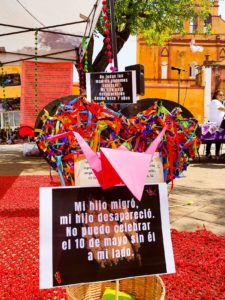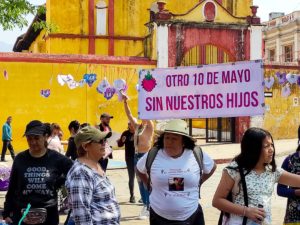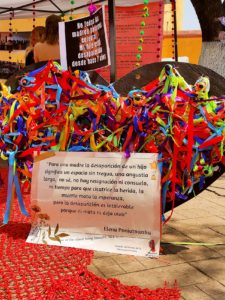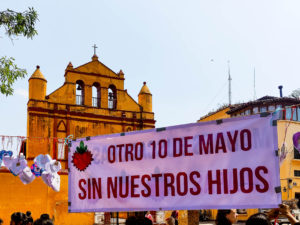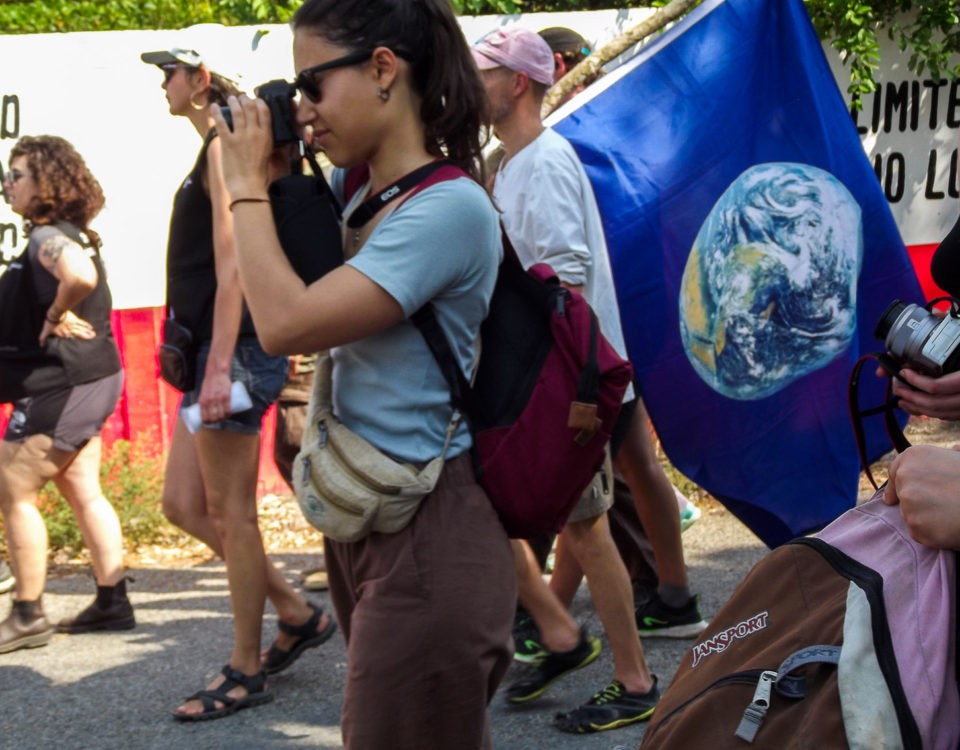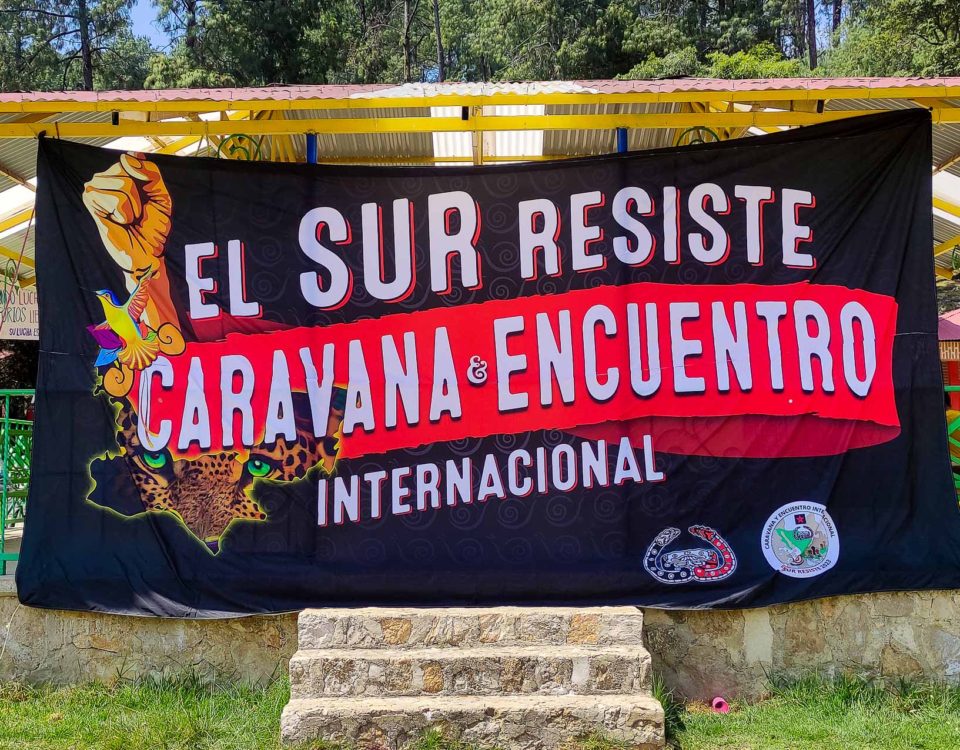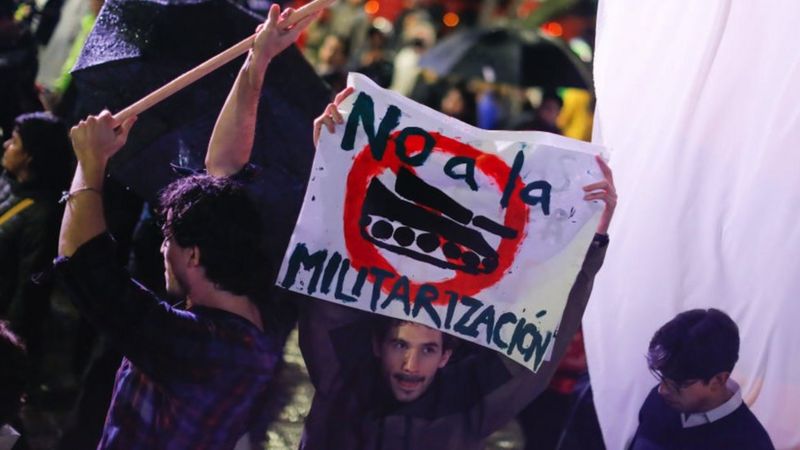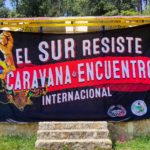
FOCUS: Megaprojects in the Mexican Southeast; Resistance of the Original Peoples in Defense of Territory and Life
17/06/2023
SIPAZ Activities (mid-February to mid-May 2023)
17/06/2023I say your name with all the silence of the night,
my gagged heart screams it.I repeat your name, I say it again,
I say it tirelessly
and I’m sure there will be dawn.
T o disappear, is it a verb that can be applied to people? Thinking logically, the answer would be no, at least not beyond the realm of illusion and magic. Nevertheless, reality has surpassed the unimaginable.
Disappeared; it is a concept that is increasingly present in our daily lives. Every day we usually find ourselves in the media and on the streets, with a pitiful amount of search files, with cries for help from desperate families looking for a loved one.
Disappearance is one of the most extreme forms of violence. Entire families have been devastated by the uncertainty and pain of not knowing what happened to their relatives. As Elena Poniatowska mentions, “for a mother, the disappearance of a child means a space without truce, a long anguish. There is no resignation or comfort, nor time for the wound to heal. Death kills hope, but disappearance is intolerable because it neither kills nor lets live.”
Forced disappearance in Mexico has its roots in the so-called “Dirty War” but its practice has been perpetuated and is no longer just an exclusive tool of governments. It now has extremely violent forms and different aims ranging from fear-mongering to recruitment and trafficking. It occurs in multiple contexts and by different players; many times even as a strategy of terror on the State´s part, to which have been added the “disappearances carried out by organized crime groups and drug cartels, in many cases with the collaboration of state officials”; as indicated in the report “Enforced Disappearance in Mexico: A View from the Organizations of the United Nations System.”
Likewise, Human Rights Watch, in its 2023 world report, mentions that “since the start of the “war” against organized crime in 2006, violent crime rates have suffered a drastic increase in Mexico, and reached historic levels during the government of Andres Manuel Lopez Obrador. While authorities often attribute this violence to criminal cartels, most crimes go uninvestigated and those responsible are never identified or prosecuted.”
During this six-year term, we have also witnessed the increase in the presence of military forces in the country with the justification of fighting organized crime. In this regard, the report mentions: “Soldiers, police officers, and agents of the Public Ministry have committed serious human rights violations in a generalized manner, which include torture, forced disappearances, and extrajudicial executions, with almost absolute impunity.” They have registered between 35 and 40 sentences for disappearance of the more than 100 thousand cases.
Currently, it is officially recognized that there are more than 112,000 missing persons in Mexico and more than 52,000 unidentified bodies. If we add to this that, according to statistics, “close to 90% of crimes are never reported, a third of reported crimes are never investigated, and less than 16% of investigations are “solved”, the figure could still be greater”, according to the same report.
Given this panorama and the need for families to find answers and obtain justice, at least 130 search groups have emerged in the country, the majority made up of relatives of disappeared persons. Many of them are led by mothers who tirelessly search for their children, even doing excavation work in the more than 4,000 clandestine graves that have been found across Mexican territory. They have had to train as they go along in various disciplines, including forensics.
In addition to the tasks of search, dissemination, demand for truth, justice, reparation, non-repetition and memory, the groups of relatives of disappeared persons have found themselves with the need to appropriate public spaces to highlight the serious crisis that the country is going through. In various states of the Republic, we can find memorials, monuments, roundabouts and various spaces where those who are missing are remembered, such as the Glorieta of the Disappeared in Mexico City. Similarly, on some occasions they take to the streets of the cities to remind us that #wearemissingover100 thousand (#nosfaltanmásde100mil) and that they will not stop until they find them.
This work has placed families at a high level of exposure, which, in turn, has placed them at enormous risk. To the present, more than ten searching mothers have been killed. But, despite the challenges, threats, and re-victimization they face, relatives of the victims and activists, together with human rights organizations, continue to fight. Thanks to their work and the pressure they have exerted, they have managed to promote networks such as the Movement for Our Disappeared in Mexico, among others, that seek to highlight the cases, demand justice, and promote effective public policies to prevent and address this problem.
In addition, mechanisms such as the National Commission for the Search for Persons have been established, and changes have been promoted in the legal field such as the General Law on Forced Disappearance and the Approved Search Protocol. All of them have the objective of coordinating the efforts for the search and identification of disappeared persons.
There is still a lot to change, new laws and organizations that comprehensively address this crisis, but it is extremely important to recognize what families have achieved on their journey.
Chiapas: A critical point of the painful reality of disappearances
Chiapas, one of the poorest and most marginalized states in Mexico, faces a particularly worrying situation in relation to disappearances. In this region, socioeconomic inequality, territorial conflicts, and political tensions have contributed to a climate conducive to violence, the breakdown of the social fabric, and impunity. On the other hand, the strategic location of Chiapas has placed it at the center of dispute for various organized crime groups, which has increased the commission of crimes such as kidnapping and disappearance.
Currently, the figures in the state are not clear, because, as at the national level, due to fear and lack of confidence in the authorities, not all cases are reported. The Fray Bartolome de Las Casas Human Rights Center has registered 1,314 cases; the organization Melel Xojobal has documented at least 1,831 disappearances of children under 18 years of age between 2018 and 2021. For its part, Voces Mesoamericanas Accion con Pueblos Migrantes (Mesoamerican Voices Action with Migrating Peoples), has more than 350 cases of disappeared agricultural laborers from Chiapas. These organizations agree that, in the last four years, disappearances have increased exponentially and steadily. It is estimated that these figures may be much higher.
In Chiapas, once again, it is the families and human rights organizations that are making efforts given this crisis. Thus, in 2010 the Junax Ko ́tantik Committee was formed with families of disappeared migrants from Chiapas. Also, the Working Group Against Disappearances in Chiapas, who have urged the authorities to “recognize the problem and work together to find them and stop the crisis.” They have also pointed out the need to create a context analysis unit both in the Enforced Disappearance Prosecutor’s Office and in the State Search Commission, to be clear about what is happening and for what purposes.
The search for truth and justice for the victims and their families is an urgent and necessary task. Search collectives across the country are a reflection of the lack of results from governments; but also, they are a symbol that when there is a will, many things become possible. They are an example of strength, struggle, hope, union and, above all, love.
#Hastaencontrarles

